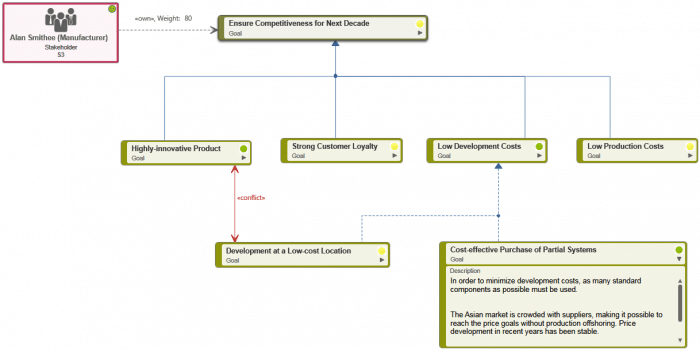The Goal Diagram. The Basis for Good Requirements.
What does a Goal Diagram show, why are Goals important, and what are the Benefits of Goal Diagrams?

A goal diagram is a graphic representation of goals, the relationships among stakeholders and among goals themselves.
Stakeholders: people who, for example are interested in a new solution or pursue goals. The weighting is an expression of how important a goal is to a particular stakeholder.
Goal diagrams are also described as AND/OR graphics. An AND connection elaborates on the various other sub-goals that need to be achieved to make the larger goals possible.
Conflicts can arise between two goals when they contradict each other in part or in full. Recognizing these as early as possible is an important aim of goal diagrams.
OR connections: when one goal has sub-goals, only one of which needs to be achieved to make the larger goal possible.
What Are Goals?
Stakeholders have objectives. They want a planned or existing system to help them achieve these objectives. Consequently, a system has to possess certain characteristics and functionalities. The description of such a charateristic or functionality (also called feature) on the basis of stakeholder objectives is what we call a goal.
Klaus Pohl summed it up briefly and concisely in his book Requirements Engineering – Grundlagen Prinzipien, Techniken:
A goal is the intentional description of a characteristic feature of a system to be developed, or of its accompanying development process
Why Are Goals Important?
Goals are the best way to elicit the requirements for your system. They express what a stakeholder wants – sounds simple, doesn’t it? In practice, it isn’t, because knowing your stakeholders goals is the only way to find out what he or she expects from a system, and what to develop.
The success of a project can be ascertained by looking at whether or not the goals were achieved. That means that the goals are not just signposts at the beginning of a project but they offer orientation throughout the undertaking as well as at the end, when a product has been created, a solution has been found or a service rendered. The achievement of the goals and the communication with stakeholders about them is an important part of taking advantage of its benefits.
Goals are objectives a stakeholder aims to achieve with the help of a system.
Why Is It Important To Record Goals?
Of course goals can change over the course of time – but writing them down has still been shown to contribute greatly to their actual achievement. What happens when we don’t write them down though? They are either knowingly or unknowingly imbued with new priorities during the project. They are either partially or totally forgotten. Or they are reinterpreted. New goals begin to be added and change the direction of the undertaking. Without the appropriate documentation a new goal could begin to seem more important than an older one. The recording of goals allows us to sustainably focus goals on the interests of the stakeholders in the long run.
What Is a Goal Diagram?
In goal diagrams – also known as goal models – you map AND decompositions and OR decompositions. In an AND decomposition, a goal is refined into subgoals that must all be met in order to fulfill the goal. AND-decompositions can be recognized by solid lines in the target diagram. In an OR decomposition, a goal is also broken down into subgoals, but only one of them must be fulfilled in order to fulfill the goal. OR decompositions are represented by interrupted lines. Target graphs are also called AND/OR graphs.
The Relationships within Goal Diagrams
Goals inherently are interconnected. They could be contradictory, for example. As described in the goal diagram above, they can be used to develop a highly innovative product or they could lead to a conflict. This conflicting relationship is expressed as a “conflict” on the diagram. It is also possible that the achievement of one goal can lead to the fulfillment of another. These kinds of relationships can be represented with the label “demand”.
Goal Diagrams illustrate goals as well as their relationships with other goals and their importance for stakeholders.
Advantages of Goal Diagrams
Goals provide orientation. Goal diagrams allow us to understand our aims more easily. Not just individual goals necessarily, but a complex interrelationship of various ones. Contradictions and conflicts can be identified early on – ideally making development errors easier to avoid. Priorities can be ascertained more definitively. The same goes for AND/OR connections. This simple visualization of the inter-relationships makes class diagrams much more advantageous compared to ordinary tables.
Goal diagrams are very easy to read and create using good software. They also form the ideal basis for the finding making a correct assessment of a company’s needs.

